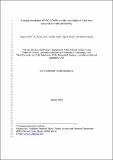A newly developed APCC SCoPS and its prediction of East Asia seasonal climate variability
Author(s)
Ham, Suryun; Lim, A-Young; Kang, Suchul; Jeong, Hyein; Jeong, Yeomin
Download382_2018_4516_ReferencePDF.pdf (4.731Mb)
Terms of use
Metadata
Show full item recordAbstract
Abstract
The Asia Pacific Economic Cooperation (APEC) Climate Center (APCC) in-house model (Seamless Coupled Prediction System: SCoPS) has been newly developed for operational seasonal forecasting. SCoPS has generated ensemble retrospective forecasts for the period 1982–2013 and real-time forecasts for the period 2014–current. In this study, the seasonal prediction skill of the SCoPS hindcast ensemble was validated compared to those of the previous operation model (APEC Climate Center Community Climate System Model version 3: APCC CCSM3). This study validated the spatial and temporal prediction skills of hindcast climatology, large-scale features, and the seasonal climate variability from both systems. A special focus was the fidelity of the systems to reproduce and forecast phenomena that are closely related to the East Asian monsoon system. Overall, both CCSM3 and SCoPS exhibit realistic representations of the basic climate, although systematic biases are found for surface temperature and precipitation. The averaged temporal anomaly correlation coefficient for sea surface temperature, 2-m temperature, and precipitation from SCoPS is higher than those from CCSM3. Notably, SCoPS well captures the northward migrated rainband related to the East Asian summer monsoon. The SCoPS simulation also shows useful skill in predicting the wintertime Arctic Oscillation. Consequently, SCoPS is more skillful than CCSM3 in predicting seasonal climate variability, including the ENSO and the Arctic Oscillation. Further, it is clear that the seasonal climate forecast with SCoPS will be useful for simulating the East Asian monsoon system.
Date issued
2018-10-27Department
Parsons Laboratory for Environmental Science and Engineering (Massachusetts Institute of Technology); Massachusetts Institute of Technology. Department of Civil and Environmental EngineeringPublisher
Springer Berlin Heidelberg